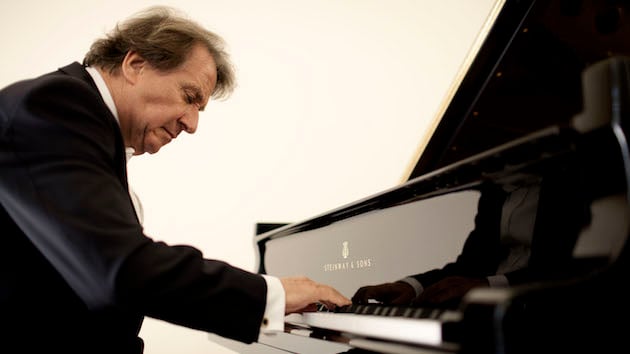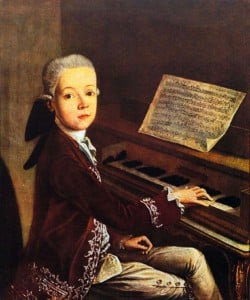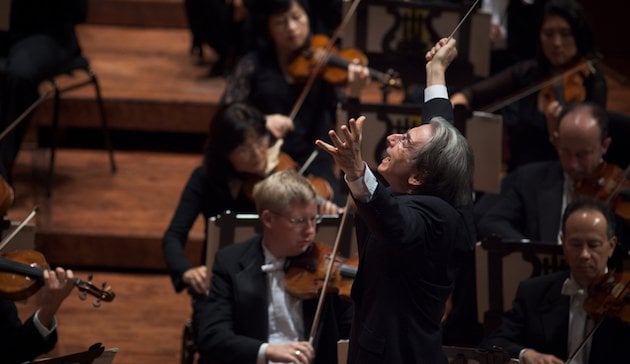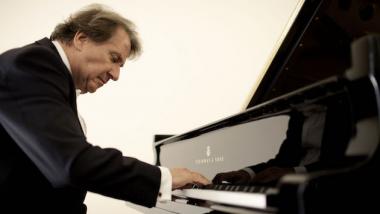
Wolfgang A. Mozart was a precocious brat. He earned admiration throughout Europe, as he and his sister, Maria Anna (Nannerl), were paraded around Europe by their father Leopold. But none was more impressed than Pope Clement XIV when young Wolfgang, then 14 years old, heard the closely guarded Miserere mei, Deus by Gregorio Allegri, in the Sistine Chapel, then wrote it down from memory.

It had been sung exclusively at the Sistine Chapel on Holy Wednesday and Good Friday, but Mozart “leaked” the score to the outside world. The Pope summoned Mozart back to the Vatican and praised the boy instead of excommunicating him, and awarded him the Chivalric Order of the Golden Spur for the extraordinary feat. With the ban lifted, the work became popular.
Such was the story Michael Tilson Thomas told from the stage before the Men of the San Francisco Symphony Chorus and the Pacific Boychoir spread out around the orchestra floor of Davies Symphony Hall to sing the Miserere. While the acoustics may not have matched that of the Sistine Chapel, the voices surrounded the audience to create an immersive soundscape, prompting us to thank Mozart for bringing such beauty out of the Vatican.
The music is challenging to perform, particularly with several high C's sung by one of the boy sopranos in the quartet on the terrace. Its difficulty may have been one of the reasons for being restricted to the Vatican. The unnamed soprano’s voice was unwavering, and he sustained the high note with a piercing quality that resonated around the hall, several times larger than the chapel. The feat is more impressive today, because typical pitch in Allegri’s 17th-century Rome was substantially lower than today’s standard. The chorus was rewarded with an enthusiastic standing ovation, but this unusual beginning to the evening provided a segue into a work by a decidedly different Mozart.
The work in question, the Piano Concerto in D Minor, K.466, is a rarity among the 23 concerti written by Mozart, because it is in a minor key. At the piano was the unapologetically Viennese pianist, Rudolf Buchbinder, who last appeared with the San Francisco Symphony under conductor emeritus Herbert Blomstedt, in 1985.
Buchbinder held a tight rein on the music despite the omnipresent temptation to romanticize it. The piece includes all the essential materials for that treatment, from the dark brooding theme to angry outbursts. Because it was written in 1785, when Mozart was not quite 30 years old, Buchbinder maintained careful balance to ensure that it wasn’t catapulted into the 19th century. Perhaps the piano’s more pronounced attack followed by a rapid decay in the treble was helpful in maintaining the classical style, though the stern tonal quality of the piano was decidedly modern. I wished for more power in the treble, particularly in the middle part of the second movement where the left hand crosses over the right. Even with reduced numbers, the orchestra overwhelmed the treble range of the piano, leaving it barely audible. Yet, the lyricism of the remainder of the second movement soared.
Buchbinder’s command, throughout the piece, was impeccable. Articulations were extraordinarily clear, and distinct colors were delivered through decisive use of the una corda (soft) pedal that seemed to give the instrument two separate personalities. The brisk Rondo moved along with a laser-sharp focus, without succumbing to romantic indulgences and temptations. Generous application of the sustain pedal gave the piano a frequently sorrowful character, but stopped short of blurring the lines.

Such careful restraint contrasted with an extravagant reading of Brahms’ Symphony No. 2 in the second half of the evening. From the opening, the orchestra’s sonority was rich and indulgent, presenting an expansive soundscape, peppered with rhythmic tensions from syncopations in the score. The work was written in 1877, when Brahms was 44 and at the height of his career, and MTT delivered a thoroughly indulgent reading. There was almost a hint of Mahler, 27 years Brahms’ junior, with much exuberance and extravagance throughout. This is not particularly surprising given the conductor’s extensive work on Mahler symphonies.
In a way, both the Mozart and the Brahms works were foretelling what was inevitable shortly thereafter: the early Romanticism of Beethoven and Schubert and the hyper-romanticism of Mahler following Brahms. The Miserere’s connection to Mozart’s may have been fortuitous in that it gives us a deeper appreciation for the music he left us.

